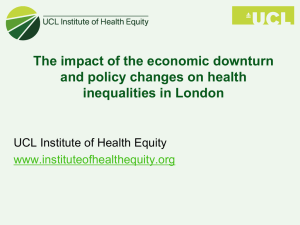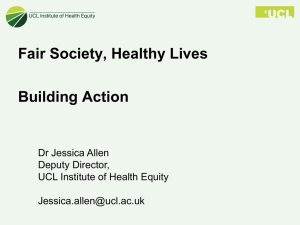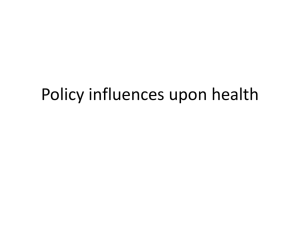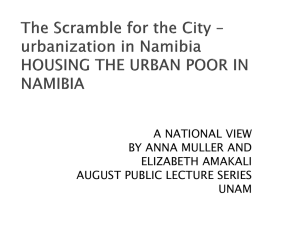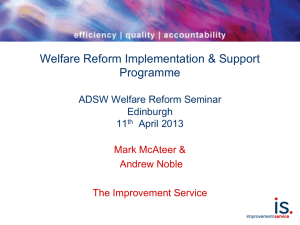Jessica`s presentation
advertisement
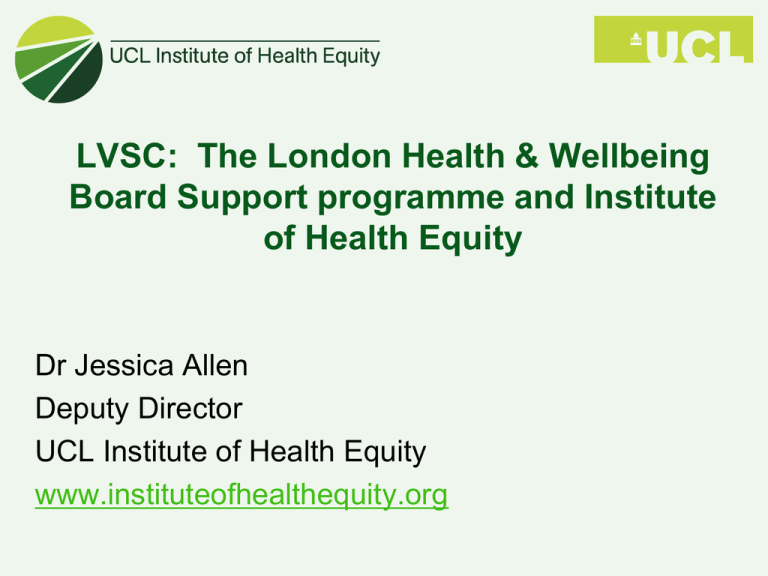
LVSC: The London Health & Wellbeing Board Support programme and Institute of Health Equity Dr Jessica Allen Deputy Director UCL Institute of Health Equity www.instituteofhealthequity.org IHE Work with London Commissioned by the London Health Inequalities Network via GLA and London Councils. • London partner in Marmot Review - Work with Mayor Office – including Health Inequalities Strategy • Input into early years and alcohol strategies • Work on fuel poverty in London • Indicators –Marmot indicators and LHO report • London Welfare and Recession Report • Development of indicator set for London • Offer to all local authorities to draw on IHE expertise on SDH – input into Joint Strategic Needs Assessments, workshops with Health and well-being boards. London Recession and Welfare report Impact of Welfare and Economic Downturn in London • To assist local authorities in London to identify and mitigate negative impacts of the economic downturn and welfare reforms on health inequalities and the social determinants of health to 2016, particularly employment, income and housing impacts, by providing the following: • • • Literature review on the likely impacts. Some recommendations regarding what local authorities could do to minimise any negative effects. A set of indicators that local authorities should use to monitor the impact of the changes – in development.” Evidence from previous economic downturns suggests that population health will be affected: • • • • • • More suicides and attempted suicides; possibly more homicides and domestic violence Fewer road traffic fatalities An increase in mental health problems, including depression and possibly lower levels of wellbeing Worse infectious disease outcomes such as TB + HIV Negative longer-term mortality effects Health inequalities are likely to widen The report specifically looks at the impact of the recession on income, employment and housing: • The economic downturn is causing a rise in unemployment, a fall in income for many households, which in turn may cause housing problems for those who experience lower incomes. – London unemployment up from 6.7% (Q2 2008) to 10.1% (Q1 2012) – There is a shortage of affordable homes in London. The number of homeless people and those living in overcrowded homes has risen. • Unemployment, low incomes and poor housing contribute to worse health. • These problems are more likely to occur among particular groups within the population and among those already on low incomes. Impact of the welfare reforms • £18 billions welfare savings • Intended to strengthen incentives to work, but there is a shortage of jobs. • Many households face reduced benefits – lower incomes, harder to cover housing costs. • Affects low-income households, in particular: – – – – – – Workless households and those in >16 hours/ week low-paid work Households with children Lone parents, possibly also women in couples Larger families Some minority ethnic households Disabled people who are reassessed as ineligible for the Personal Independence Payment – Private rented tenants. London demographics • London has high numbers of some groups more ‘at risk’ of impacts of welfare reforms: • • • Young people Minority ethnic and immigrant population Lone parents households. • Population growth will put additional pressure on housing and other local resources. London recession indicators • To measure impact of recession and welfare changes - Currently piloted 4 domains • Employment domain • Income and migration of vulnerable families domain • Housing domain • Health and well being domain IHE support to HWBBs • 19 have drawn on offer • Variety of requests – – – – – – Understand causes of health inequalities Understand what happening locally - data Assess JSNAs and HWBSs Think through what to do – early years, NEETs, housing Persuade board and political members of importance Persuade other sectors (eg children’s services, police, fire) – Partnership working – public health new • Assets based approaches/community development? • Levers and mechanisms? – Health inequalities duties • Duty to pay regard to inequalities in access and outcomes related to health services. Less focus on • Community and voluntary sector involvement (though Tower Hamlets a bit different) • Public, healthwatch involvement in HWBBs • Most excluded groups There are levers where not happening – inequalities duties, duty of integration Institute website: www.instituteofhealthequity.org Full report: http://www.instituteofhealthequity.org/Co ntent/FileManager/pdf/london-full-repmedium-res.pdf

